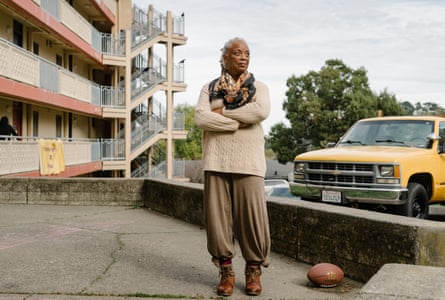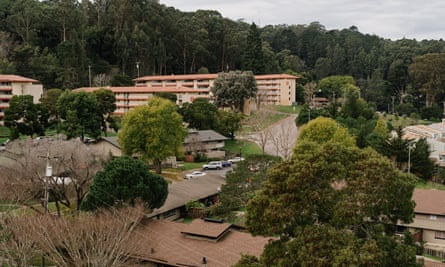Karen Ashby’s apartment in a five-story high-rise in Marin City, California, sits on a hillside bordered by preserved open space, just above an estuary in a secluded arm of the San Francisco Bay. The surroundings are idyllic, but the two-bedroom apartment she rents there is falling apart. The window screens are coming loose, the cabinets and appliances are old and damaged, and the unit hasn’t been painted in over a decade.
Ashby is one of almost 700 low-income tenants at Golden Gate Village, a public housing project a few miles north of San Francisco, in one of California’s wealthiest counties. Both the project’s residents and local authorities agree the complex is in dire need of renovations. But some tenants fear plans to overhaul the site will lead to a cycle of gentrification and displacement that has played out in other parts of the Bay Area, and uprooted black communities.
Some residents at the government-owned complex face even worse issues than Ashby does, including faulty heating systems, mold, hazardous electrical wiring and rodent infestations, according to a 2018 inspection report. “It’s beautiful here, but they don’t keep it up,” Ashby said.
As part of a plan to address the lamentable living conditions, officials have proposed building new market-rate and subsidized apartments and townhomes, and possibly demolishing dozens of existing units to make way for a portion of the construction. This “mixed-income” housing strategy has become an increasingly popular way to revamp crumbling public housing infrastructure in cities across the United States. In Marin City, officials contend it is needed to pay for the at least $66m in short-term and long-term repairs at the property.
The local housing authority says it will take steps to ensure that no tenants are involuntarily displaced by the renovations. But years of delayed maintenance at Golden Gate Village, coupled with the region’s history of discriminatory housing policies, has contributed to what the county’s civil grand jury described as a “profound level of distrust” by some residents of officials’ intentions for redeveloping the bayside real estate.
And experts stress that this permanent low-income housing is often the only thing keeping many longtime residents in the area. “Making sure this kind of subsidized housing is healthy, safe and affordable is a key stabilizing factor for neighborhoods that would otherwise be facing gentrification,” said Anna Cash, program director of the University of California’s Urban Displacement Project.

Housing safe haven
About 400 of Golden Gate Village’s 700 tenants are African American. As officials have spent over a decade discussing how to restore the ageing site, comprising eight high-rise and 20 low-rise buildings, these residents have watched as urban development and a tech-fueled housing crunch have reshaped black communities in nearby San Francisco and east Bay Area cities such as Oakland.
Between 2000 and 2015, the Longfellow neighborhood in Oakland lost 30% of its low-income black households, according to a report by the Urban Displacement Project. Meanwhile in San Francisco, low-income black households in historically African American neighborhoods dropped 17%.
While Marin City’s African American population – of which a quarter live below the poverty line, according to most recent census estimates – has declined over time, Golden Gate Village has protected many of the area’s lowest-income black residents from being pushed out. But the unincorporated community has a legacy of displacement that can be traced back to the 1940s.
Black families originally moved to Marin City to work at local shipyards during the second world war. There, thousands of workers and their families lived together in a fully integrated government housing.
After the war, many white residents, aided by federal subsidies, bought homes in other parts of Marin county. Royce McLemore, the Golden Gate Village resident council president, remembers how black residents took over the businesses that white owners left behind.
“We had everything: a barbershop, a grocery store, a pool hall, a beauty shop – it was very self-contained,” she said.
But in the early 1960s, the government tore down the wartime residences. Racist “redlining” policies kept blacks from moving elsewhere in the county, and many eventually ended up in newly constructed housing projects including Golden Gate Village. The bustling neighborhood McLemore describes gave way to a segregated enclave with few black-owned stores and limited economic opportunity.
Additional development in subsequent decades brought in new demographics to the area. Meanwhile, Marin became one of the most affluent counties in the region, with average rental costs now among the very highest in the nation.
Even as Marin City became more diverse, patterns of discrimination persisted. In 2009, a federal investigation found that Marin county was failing to build enough affordable housing and that the shortage contributed to the concentration of minority residents in specific neighborhoods, including Marin City. The development-averse county has since entered into an ongoing agreement with regulators to add more low-income units. Today, African Americans make up about a quarter of Marin City’s 3,000 residents but just 2% of the county’s total population, according to census estimates.

Privatization or gentrification?
The Marin Housing Authority’s final proposal for Golden Gate Village, which it aims to present to the county’s board of supervisors in coming months, includes up to 170 new units of mixed-income housing, some of which could serve as temporary residences for tenants during renovations.
The plan would also probably transfer ownership and management of Golden Gate Village to the project’s developer, New Jersey-based Michaels Development Co, or another private entity. The housing authority would then start administering federal housing vouchers to residents to help cover rent.
Similar privatization plans are under way at projects in urban, suburban and rural neighborhoods across the country. The US department of Housing and Urban Development (Hud), which has long struggled to adequately fund public housing, touts the scheme as a way to quickly refurbish complexes falling into disrepair. In Marin City, the change would make it easier to take out loans and access federal tax credits to finance the overhaul, according to officials.
“We understand the current formula of 100% public housing is not the way to fund these projects,” said Lewis Jordan, director of the Marin Housing Authority.
Jordan said the agency involved tenants in each step of the planning process, including in discussions for increasing community space and maintaining the historic heritage of the site.
“What people are saying is, ‘I want a better housing choice’, and we’re working with them to provide that,” he said.
But the Golden Gate Village residents council, the tenants’ elected official representation, opposes the agency’s plan and has presented its own “deep green” rehab proposal calling for no new development.
“We want to make sure extremely low-income people can still afford to live here,” said McLemore of her plan, which she said has garnered more than 200 resident signatures in support. “We have to look out for our rights and protections.”
The housing authority, for its part, said only a “small handful” of residents actively oppose its revitalization plan.
Despite officials’ assurances, the proposed privatization sounds a lot like gentrification to some residents. Their fears may not be unfounded, according to Edward Goetz, director of the University of Minnesota’s Center for Urban and Regional Affairs.
“Research shows when mixed-income developments are created, they are often managed in the interest of the market-rate residents,” Goetz said.
Past privatization efforts in the 90s and 00s, such as the Cabrini-Green redevelopment in Chicago, led to the “mass displacement” of public housing residents, Goetz noted. Hud says new regulations have put in place additional tenant protections after privatization, including a “right to return” to a complex once renovations are complete. But housing advocates say a lack of oversight can make it difficult to ensure private managers don’t unlawfully evict tenants and worry about loopholes allowing for the removal of certain low-income units, Goetz added.
Resident council president McLemore would rather see a community land trust take over the site. It’s unclear whether Hud would permit such an arrangement. Still, McLemore envisions forming a not-for-profit trust that would allow residents who invest in the property to eventually transfer their units to close relatives.
“There’s a lot of black people who left Marin City that reminisce about their community,” she said. “You used to be able to leave and come back, but you can’t do that any more – we want to give them that opportunity.”
And as affordable housing options dwindle throughout the Bay Area, current residents like Ashby increasingly rely on preserving Golden Gate Village as a home for low-income people.
“I don’t have anywhere else to go,” Ashby said. “I can’t see myself finding anywhere else – I can’t afford it.”
